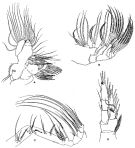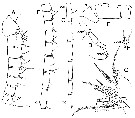|
|
 |
|
Calanoida ( Order ) |
|
|
|
Calanoidea ( Superfamily ) |
|
|
|
Megacalanidae ( Family ) |
|
|
|
Bradycalanus ( Genus ) |
|
|
| |
Bradycalanus gigas Sewell, 1947 (F) | |
| | | | | | | Ref.: | | | Sewell, 1947 (p.28, figs.F); Björnberg, 1968 (p.87: Rem.); Silas, 1972 (p.645); Michel, 1994 (p.182, Rem.); Bradford-Grieve & al., 1999 (p.877, 906, fig.F) |  issued from : R.B.S. Sewell in The John Murray Expedition, 1933-34, Scientific Reports, VIII (1), 1947. [p.29, Fig.3]. Female (from Zanzibar area): A, Mx1; B, Mx2; C, Mxp; D, P1. Nota: Proportional lengths of prosome and abdomen as 76 : 24; Head and 1st thoracic segment separate, 4th and 5th separate. Rostral filaments short and stout, directed backwards, above their base is a small median papilla from which arise 2 minute sensory hairs. Forehead rounded. Posterior thoracic margins rounded. Abdomen 4-segmented, proportional lengths with caudal rami as 48:19:11:6:16 = 100.Genital segment symmetrical, somewhat swollen anteriorly (ventral aspect). A1 (25-segmented) almost exactly in length to the body; 24th segment short, and both it and the 23rd bear a very stout and strong plumose filament. In Mx1 the 1st inner lobe bears in all 15 spine-like setae, of which those arising from near the base are fringed with hairs, while the more distal 6 are stout and strongly chiyinised; the anterior aspect of this lobe is clothed with short hairs; 2nd lobe is long and curved and bears one short and 4 long setae. 3rd lobe short and bears 2 setae; 2nd basal segment and 1st segment of endopod fused; 4 setae arise from the basal part and 2 from the distal inner angle of the portion corresponding to the 1st segment of endopod; 2nd endopodite segment with 1 seta, 3rd segment with 5 setae, and a short, curved, spine-like process arises from the anterior aspect of the segment.; exopod with 8 long setae and a 9th appears to have broken off, and 2 shorter ones spring from the margin proximally, making 11 in all; the 1st outer lobe bears 7 long setae and 2 short ones proximally; the 2nd outer lobe is apparently without seta. In Mx2 the 1st lobe bears 6 setae, the 2nd 3, of which one is stout and claw-like, the 3rd 2 setae, the 4th 3, one of which and the other two scythe-like and closely fringed with hairs is claw-like, the 5th lobe bears 3 setae, one being small and the other two scythe-like, the next lobe bears 1 scythe-like seta and a very small plain seta; from the endopodal portion of the limb arise 5 scythe-like setae and one moderately small plain seta, all scythe-like setae are fringed with a very closely set row of fine hair-like spinules along the inner margin. P5 closely resembles that of B. sarsi (Farran) as figured buy Sars (1924, Ll.III, fig.12).
|
 Issued from : J.M. Bradford-Grieve, L. Blanco-Bercial & G.A. Boxshall in Zootaxa, 2017, 4229 (1). [p.68, Fig. 35]. Female (from DIVA III, Stn 40-S): A-B, habitus (dorsal and lateral, respectively); C, forehead (lateral); D, exopod of A2; E, Md gnathobase; F, P1 (anterior view). Scale bars: 1.0 mm (A, B, F); 0.1 mm (C, D, E). Nota: - Anterior head bluntly rounded. - Posterior pedigerous somite 5 rounded with short lappets. - A1 extending to caudal rami or slightly beyond (about of 3 segments beyond the caudal rami). - Genital double-somite in dorsal view with slight bulge at about anterior 1/4. - A2 inner surface of coxa and outer distal border of endopod segment I apparently without spinules; exopod segments I-III each with moderately well-developed setae, seta on segment IV extending beyond distal border of segment VIII. - Mxp 2nd most proximal seta on endopod segments 3-5 half length of longest seta. - P1 exopod segment 3 about 2.6 times as long as maximum width; distal border of endopod segment 1 extends well beyond distal border of exopod segment 1; outer articulated spines on exopod segments 1 and 2 extend as far as base of more distal spine, proximal spine of exopod segment 3 extends beyond base of distal spine by about half its length.
|
 Issued from : J.M. Bradford-Grieve, L. Blanco-Bercial & G.A. Boxshall in Zootaxa, 2017, 4229 (1). [p.69, Fig. 36]. Female: A, A1 ancestral segments I-IX; B, ancestral segments X-XVII; C, ancestral segments XVIII-XXIII; D, ancestral segments XXIV-XXVIII; E, detail of dorsal surface of segments I-V (hs = hair sensillum); F, detail of segment XXVIII; G, Mx1 coxal endite, basal endites 1 and 2 and endopod; Scale bars: 1.0 mm (A-E; 0.1 mm (F, G). Nota: - A1 hair sensilla, one each on ancestral segments I-V, conspicuous. - Mx1 coxal endite with 5 setae, one of them very short; endopod segment 3 with vestigial posterior surface seta.
|
 Issued from : J.M. Bradford-Grieve, L. Blanco-Bercial & G.A. Boxshall in Zootaxa, 2017, 4229 (1). [p.66, Table 7]. Morphological characters after identification key of Bradycalanus females and males. Compare to other species of genus. Main characters identification after species key : 1 - Head rounded; posterior pediger 5 corners triangular in lateral view; Mx1 coxal endite with 5 setae. 2 - Female A1 short extending no more than 3 segments beyond caudal rami; P1 exopod segment 1 and 2 with outer border spines extending to base of following spine (male unknown)
| | | | | Compl. Ref.: | | | Wickstead, 1962 (p.551, food & feeding); Grice & Hulsemann, 1967 (p.13); Razouls & al., 2000 (p.343, Appendix) | | | | NZ: | 2 | | |
|
Distribution map of Bradycalanus gigas by geographical zones
|
| | | | | | | | | | Loc: | | | Antarct. (SW Atlant.), W & SW Indian (off Zanzibar Is.).
Type locality; 5.820° S, 41.470° E. | | | | N: | 3 | | | | Lg.: | | | (11) F: 14,9; (85) F: 12,0-13,0; (1316): F: 12,48-14,9; {F: 12,00-14,90} | | | | Rem.: | Abyssopelagic. Sampling depth (Antarct.) : 1000-2000 m.
Re-examination of the dissected holotype by Bradford-Grieve & al. (2017, p.67) confirmed that the baseis of endopodal segment 1 of Mx1 are fused, endopodal segment 2 has a small vestigial seta in addition to the long seta; coxal endite 1 of the M2 has 3 setae, the basal endite has 4 setae, and the 1st endopod segment lobe bears 1 large seta and 3 vestigial setae.
R. Stephen: Data sheets of NIO, Kochi, India (on line). | | | Last update : 31/07/2018 | |
|
|
 Any use of this site for a publication will be mentioned with the following reference : Any use of this site for a publication will be mentioned with the following reference :
Razouls C., Desreumaux N., Kouwenberg J. and de Bovée F., 2005-2025. - Biodiversity of Marine Planktonic Copepods (morphology, geographical distribution and biological data). Sorbonne University, CNRS. Available at http://copepodes.obs-banyuls.fr/en [Accessed August 23, 2025] © copyright 2005-2025 Sorbonne University, CNRS
|
|
 |
 |






